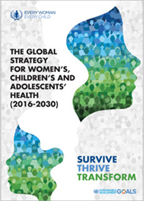
A nurse is counselling mother on appropriate breastfeeding for newborns, at Health Clinic Precinct in Malaysia.
Newborn health
A child under 28 days of age qualifies as a newborn or neonate. The first 28 days are most important for survival. In 2018, an estimated 0.6 million newborns died in India due to preterm birth, neonatal infections, intra-partum related complications/ birth asphyxia and congenital malformations. Eighty percent of these deaths were preventable.
Investing in intrapartum and newborn care services reduces the risk of dying among newborns. The Reproductive, Maternal, Newborn, Child and Adolescent Health (RMNCH+A) strategy launched in 2013 adopted a life course approach to newborn health with emphasis on the continuum-of-care and health system strengthening. The India Newborn Action Plan (INAP) 2014 was developed to provide a roadmap towards attaining the goals of ‘Single Digit Neonatal Mortality’ and ‘Single Digit Stillbirth’ rates by 2030. Further, India’s National Health Policy, 2017 endorsed the national consensus on accelerated achievement of neonatal mortality targets. India Strategy for Women’s, Children’s and Adolescents’ Health (I-WACH), launched in December 2018, takes forward the life-course approach. It describes an integrated and multisector approach, recognizing that health-enhancing factors (like maternal nutrition and education, water, clean air, sanitation, hygiene and infrastructure) are essential to address the underlying causes associated with preterm births and newborn deaths.
In 2020, India assessed its progress against the INAP 2014 milestones and targets. India has achieved the target for reducing Newborn Mortality Rate to 24 by the year 2017 and reducing stillbirth rate to below 19 by 2020.
WHO refers to preterm birth as babies born alive before 37 weeks of pregnancy. It is a leading cause of death for children below 5 years of age. In 2014, India along with China, Nigeria, Bangladesh and Indonesia was among the top five countries for estimated number of preterm births. Preterm babies are at an increased risk of post-neonatal mortality, stunting and long-term neurodevelopmental impairment during childhood.
The India Newborn Action Plan (INAP), 2014 outlines strategies to strengthen preterm births and address symptoms and other risk factors. It includes provision of antenatal corticosteroids to women in preterm labour, antibiotics for premature rupture of membranes, specialised facility-based care for sick and small newborns, Kangaroo Mother Care, follow-up home based care, access to antibiotics for bacterial infections and screening for birth defects and developmental delays. As an integrated strategy, it links interventions across continuum-of-care, from pre-pregnancy to postpartum, underlining connections between reproductive, maternal, newborn and child healthcare.
Technical links

